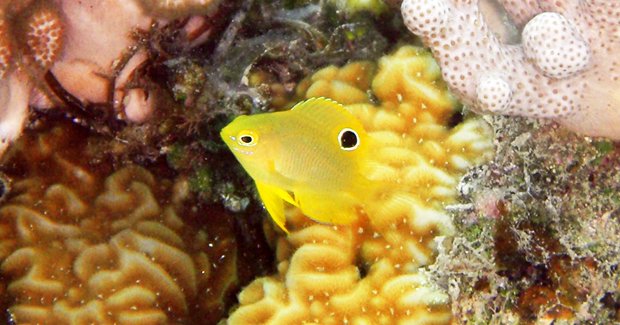Fish grows ‘false eye’ to trick predators

YOUNG DAMSELFISH GROW a ‘false eye’ on their tails when under threat to increase their chance of survival, a new study has revealed.
The research, conducted on Lizard Island on the Great Barrier Reef, found that when Ambon damselfish (Pomacentrus amboinensis) are in constant peril of being eaten by a predator, a large circular marking on their tail – their ‘false eye’ – increases in size, while their real eyes shrink.
Researchers say the purpose of the change is to create the illusion that these small fish are moving in the opposite direction, which affords them enough time to escape from predators.
Damselfish markings deter predators
Lead researcher Oona Lönnstedt, from James Cook University in Townsville, was initially investigating why damselfish lose their spot as they grow older. As part of the research, Oona and her team constructed an underwater ‘house’ and placed the prey fish in one room. In a neighbouring room, they placed a predator which was regularly fed damselfish.
“Here, the prey fish in the room were constantly exposed to the cues of their peers being eaten,” says Oona.
After six weeks, they removed the test damselfish and placed them in reef patches. The spot was drastically larger and more vivid on fish who had lived in close proximity to their predator.
“We found that when they could see and smell a predator fish without actually being attacked, these small damsels grew a bigger false eye and their actual eyes became relatively smaller, which didn’t happen to isolated damselfish.”
Oona says the test fish also differed in their behaviour. “The ones not introduced to predators in the controlled environment were far less careful.”
Prey fish behaviour on the reef
The findings, published recently in the journal Scientific Reports, also suggest that the ‘false eye’ is only necessary to damselfish early in life. “When they’re little, they’re like M&M’s – everyone wants to feed on them,” Oona explains.
Dr Robert Day, a marine biologist at the University of Melbourne, says that although the finding has been suspected for a long time, the experiment is unprecedented.
“It is very hard to design experiments to test this,” says Robert. “This is the first time that someone has been able to design an experiment like this.”
Oona says the study is particularly significant in Australia, as many species of damselfish live on our reefs. “It’s important to know how and why these animals survive, especially in an environment as fragile as a reef,” she says.
RELATED STORIES

